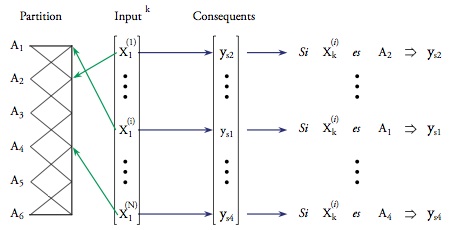Fuzzy Predictive Model of the Vertical Acceleration of a High Speed Vessel in Pitch Motion
DOI:
https://doi.org/10.25043/19098642.25Keywords:
fuzzy identification, vessel pitching, fuzzy predictive model, recursive least squaresAbstract
An adaptable fuzzy inference technique is being described in order to generate predictive models of the acceleration of the pitching of a high speed vessel, from the data obtained from the web on an experiment conducted by the University of Iowa. The geometry of interest in the experiment is a scale model of the type 1/46.6 of the DTMB model 5415 (DDG-51). The fuzzy algorithm for the generation of the predictive model uses a triangular partition with a 0.5 overlapping and consequents of the Singleton type. The consequents are adjusted in an automatic fashion by using recursive least squares. The algorithm shows a very low computational complexity rate which allows for it to be used for on line identification.Downloads
References
BEZDEK J. C. Pattern recognition with Fuzzy Objective Function Algortithms. Ed. Plenum Press. 1987.
CONTRERAS, J. Introducción al Control Automático, Editorial Escuela Naval, Almirante Padilla, Cartagena, Colombia, 2006.
CONTRERAS, J., MISA, R., PAZ, J., Building Interpretable Fuzzy Systems: A New Approach to Fuzzy Modeling. En proceedings of Electronics, Robotics and Automotive Mechanics Conference CERMA 2006. IEEE Computer Society. Pags.: 172-178. 2006.
DÍEZ J. L., NAVARRO J. L., SALA A. Algoritmos de Agrupamiento en la Identificación de Modelos Borrosos. RIAI: Revista Iberoamericana de Automática e Informática Industrial. 2004.
ESPINOSA, J., VANDEWALLE, J. Constructing fuzzy models with linguistic integrity form numerical data-afreli algorithm, IEEE Trans. Fuzzy Systems, vol. 8, pp. 591 – 600. 2000.
ESPINOSA, J., VANDEWALLE, J., Wertz, V, Fuzzy Logic, Identification and Predictive Control. Springer. Estados Unidos. 2005.
GIL, F., CONTRERAS, J. Automatic tracking of Target: Application on a Prototype of Cannon. II Conferencia/Workshop de Vehículos/Sistemas No-Tripulados (UV/S) de América Latina. Panamá. Agosto de 2008.
GUILLAUME, S., CARNOMORDIC, B. Generating an interpretable Family of Fuzzy Partitions Form Data, IEEE Trans. Fuzzy Systems, vol. 12, No. 3, pp. 324 – 335. 2004.
GUZTAFSON E. E., KESSEL W. C. Fuzzy Clustering with a Fuzzy Covariance Matrix. IEEE CDC, San Diego, California, pp. 503 – 516. 1979.
IRVINE, M., LONGO, J., and STERN, F., Pitch and Heave Tests and Uncertainty Assessment for a Surface Combatant in Regular Head Waves, Journal of Ship Research, submitted. 2006.
NAUCK, D., KRUSE, R., Nefclass - a neuro-fuzzy approach for the classification of data, In: Proceedings of the Symposium on Applied Computing. 1995.
NAUCK, D., KRUSE, R. Neuro-fuzzy systems for function approximation. Fuzzy Sets and System. 101(2), pp. 261-271. 1999.
PAIVA, R. P., DOURADO, A. Interpretability and learning in neuro-fuzzy systems, Fuzzy Sets and System. 147, pp. 17-38. 2004.
SALA, A. Validación y Aproximación Funcional en Sistemas de Control Basados en Lógica Borrosa. Universidad Politécnica de Valencia. Tesis Doctoral. 1998.
SALA, A., ALBERTOS, P. Inference error minimisation: fuzzy modelling of ambiguous functions. Fuzzy Sets and Systems, 121 pp. 95 – 111. 2001.
SANTOS, M., LÓPEZ, R., de la CRUZ, J.M., Modelo predictivo neuro-borroso de la aceleración de cabeceo de un buque de alta velocidad. RIAI: Revista Iberoamericana de Automática e Informática Industrial. 2005.
SUGENO, M., YASUKAWA, T. A fuzzy logic based approach to qualitative modeling. Transactions on Fuzzy Systems, vol. 1, No. 1, pp. 7-31. 1993.
WANG, L-X, MENDEL, J.M. Generating fuzzy rules by learning form examples, IEEE Transactions on Systems Man and Cybernetics, vol. 22, no 6, pp. 1414-1427. 1992.

Published
How to Cite
Issue
Section
License
The authors who publish in this Journal certify that:
- The work submitted for publication in The Ship Science and Technology journal, was written by the author, given that its content is the product of his/her direct intellectual contribution.
- All data and references to material already published are duly identified with their respective credits and are included in the bibliographic notes and quotations highlighted as such.
- All materials submitted for publication are completely free of copyrights; consequently, the author accepts responsibility for any lawsuit or claim related with Intellectual Property Rights thereof, Exonerating of responsibility to The Science and Technology for the Development of Naval, Maritime, and Riverine Industry Corporation, COTECMAR.
- In the event that the article is chosen for publication by The Ship Science and Technology journal, the author state that he/she totally transfers reproduction rights of such to The Science and Technology for the Development of Naval, Maritime, and Riverine Industry Corporation, COTECMAR.
- The authors retain the copyright and transfer to COTECMAR the right of publication and reproduction of the work which will be simultaneously subject to the Creative Commons Attribution License (CC -BY) , which allows the license to copy, distribute, display and represent the work and to make derivative works as long as it recognizes and cites the work in the manner specified by the author or licensor.
- For more information about the Creative Commons Attribution License (CC -BY) and his use and scope, please visit the following web page https://creativecommons.org/licenses/by-sa/4.0/legalcode








